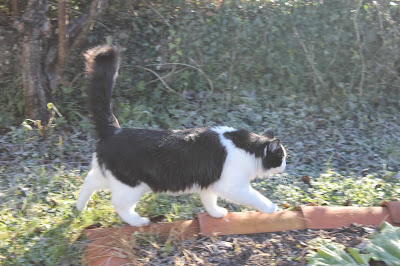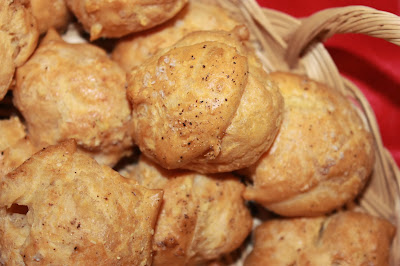I chose our larger garden squash for this bisque because how clever, efficient, and pretty is it to use the rounded bottoms as bowls? There is no need for washing as we just toss them into our composting pail. Recipes for butternut squash soup abound. Though mine is simple with just a few ingredients, roasting the squash and the garlic deepens this soup's inherent, sweet nuttiness.
INGREDIENTS
makes 5 hearty servings/8 more dainty ones
Squash, roasted using about 5 1/2 lbs of fresh, whole butternut
Garlic, roasted, 4 large cloves to one large head if you are a roasted garlic lover like me plus any unused roasted garlic can be frozen
Cream, heavy, 8 fluid ounces
Thyme, fresh, about ten sprigs
Chicken broth, homemade (or the best brand you can get), 32 fluid ounces
Bread, four large slices or an 8 inch length of French bread
Paprika, 1 tsp
Parmesan, 4 T
Butter, olive oil, salt & freshly ground black pepper as needed
Full instructions for roasting squash is here and for the garlic here. Roasting done in advance is a good idea; the actual soup takes only ten minutes or so to do. Extra baked squash comes in handy for making Butternut Squash Spice Cookies & Orange Icing. Squash seeds can be reserved for roasting. Put the scooped out seeds in a bowl of water. They will mostly rise to the top after sitting for a while. Skim them off with a slotted spoon. If they are still gooey, place them in a colander and put under running water. Dry with a dish towel/tea cloth, picking off any seeds that stick to the towel. Toss with a small amount of oil and salt until coated.
Spread them in a single layer on a baking sheet. Since a lower temperature is required, I wait until the garlic and squash is done and let the oven cool down to 300 degrees F. The seeds will take about twenty minutes to get light brown and crunchy.
For bowls, make sure you slice very thin slices off the bottom ends of the squash. Then halve the squash. Remember not to pierce right through the skin with a knife when testing for tenderness during baking as your bowl could spring a leak when filled with soup! Instead test by inserting a knife into the fleshy rims.
So many herbs and spices go well with squash soup--nutmeg, ginger, rosemary, sage--that it was hard to choose but what made up my mind is the plentiful thyme in our potager.
Coat the squash flesh with some melted butter and lay each piece cut side down on a thyme sprig.
 |
| Garlic is in the ceramic bowl |
Bread crumbs also can be prepared ahead. Preheat oven to 350 degrees F. Cube the bread and mix together the bread, paprika, and olive oil in a bowl.
Spread them in a single layer on a parchment-lined oven tray. Bake for about 8 minutes and then toss with grated Parmesan and return to the oven for another 2 minutes.
The thyme infuses the golden flesh of the squash with its fragrance.
 |
| Molten garlic gloves resemble champagne diamonds & topaz |
 |
| The croutons came out great with a little zing and a touch of cheese |
Scoop out carefully with a spoon the squash bottoms that will serve as bowls, leaving about a 1/4 inch thickness. They are pretty forgiving so weak spots could be repaired with a well placed smear of squash.
With a knife, remove the skins on the rest of the squash.
Squeeze out the garlic pulp and add to the squash.
Puree with a stick mixer. A potato masher or a fork can be used alternatively, but the texture will be way less smooth.
Put the pureed squash in a soup pot and slowly add the chicken stock while stirring till well mixed. Puree a second time with the stick blender. Add the cream and heat gently. Season to taste with salt and pepper. Serve with croutons and a sprig of thyme.
The croutons provided a tasty crunch that set off the bisque's velvety consistency, and it was fun to eat out of the special bowls!
Green is reigning supreme in the garden at present. Since our moving here about four years ago, the ivy has glumly sat on the soil, not doing much until this very rainy year. It is now covering pillars and walls and looking very lovely.
This perennial geranium is adding a spot of colour.
À la prochaine!






















































